Creating a Peaceful Home Environment to Support Your Health
Have you ever stepped into your own room and suddenly felt drained of energy? The place you live can significantly impact your health. It should be a place where you can feel relaxed and safe.
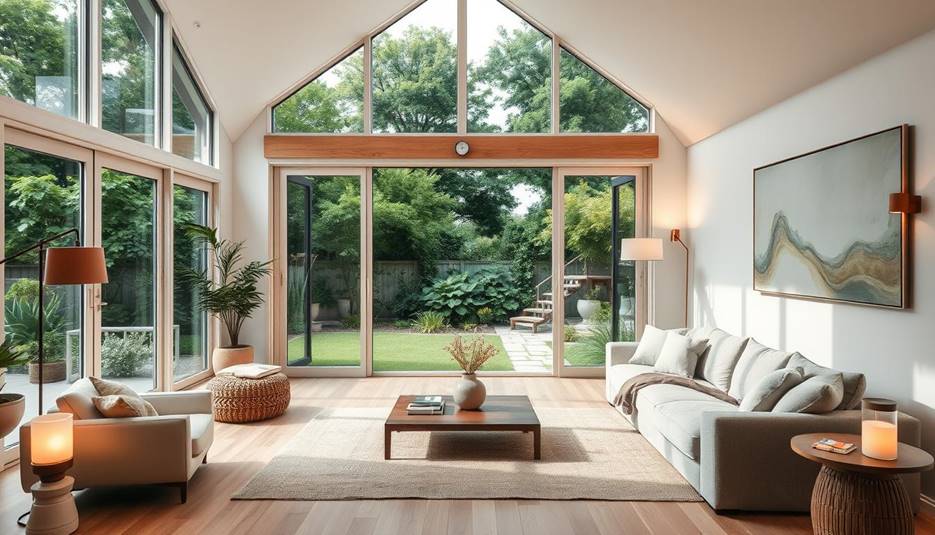
With a few easy changes, you can make your home a calming place. This can help your health and happiness.
Key Takeaways
- One peaceful living space can reduce stress and improve mental health. Research has proven that biological design reduces stress and helps in recovery. Incorporating natural elements, such as houseplants, can promote relaxation.
- A well-designed home can improve overall health and well-being.
- Simple changes to your living space can have a significant impact on your health.
- Creating a calming atmosphere is key for relaxation and stress relief.
The Science Behind Your Home Environment and Health
Your home’s surroundings can greatly affect your health. Studies show that many factors in your home can change how well you feel.
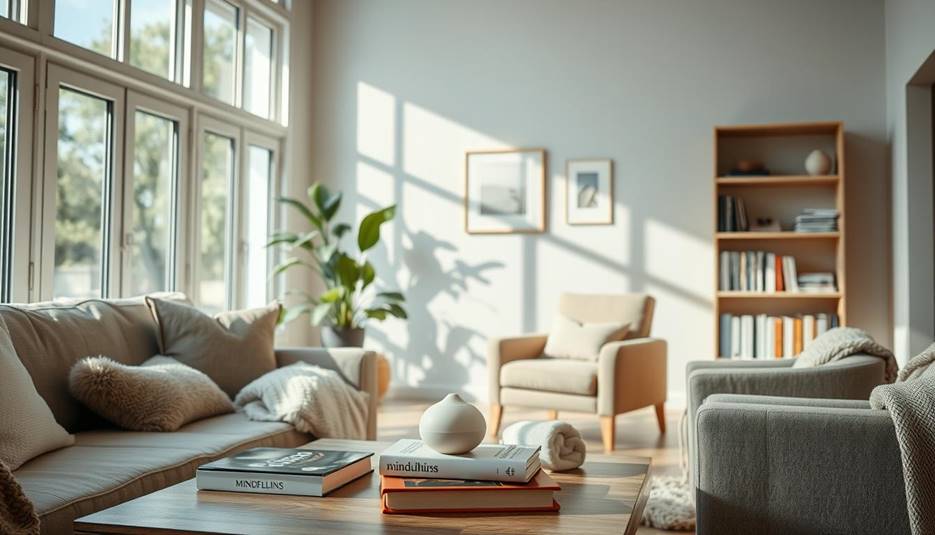
Your home can directly affect your physical health. For example, natural light can make you feel better and more energetic. But, bad air inside can cause breathing problems and other health issues. Clean and well ventilate your home is key to maintaining good health.
Indoor Air Quality: Bad air inside can make asthma worse. Make sure to check and clean your heating and cooling systems often. Also, using air purifiers can help make the air better.
The Mental Health Connection to Home Spaces
Your home’s state can also deeply affect your mental health. A messy home can make you feel stressed and overwhelmed. But, a tidy and calm home can help you feel clear-minded and less anxious.
Decluttering and Organization: Cleaning up your space regularly can really cut down on stress. Having specific areas for relaxing and working can also help keep your mind healthy.
Knowing how your home affects your health can help you make it better. Focus on both the physical, like air quality and light, and the mental, like clutter and organization.
Biophilic Design: Bringing Nature Indoors for Better Health
Embracing biophilic design can turn your home into a health haven. It brings nature indoors to boost your well-being. This trend is popular because of its many benefits.
Research-Backed Benefits: Stress Reduction and Recovery
Research has proven that biophysiologic design can help reduce stress and help recover. Exposure to natural elements reduces cortisol, heart rate, and blood pressure. A Journal of Environmental Psychology study showed a 15% reduction in stress in the office, along with nature.
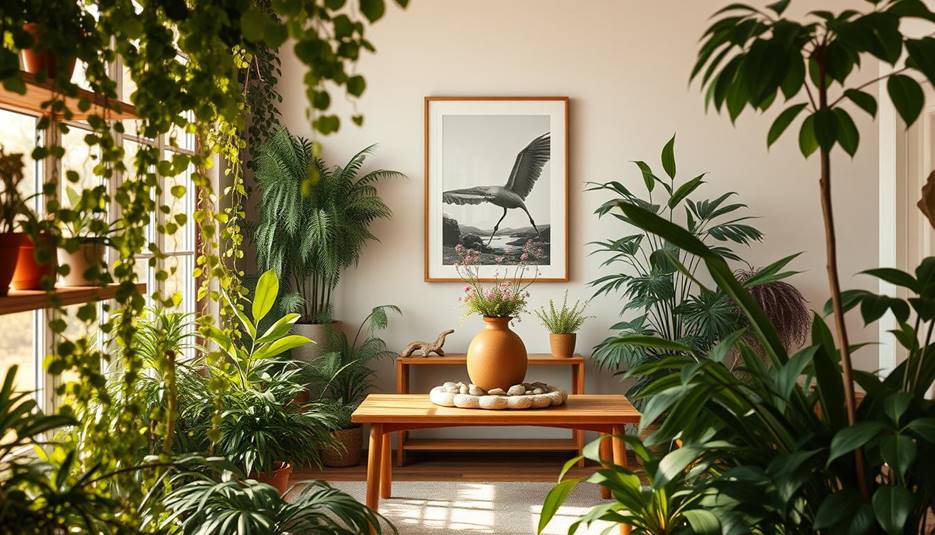
Adding nature to your home can lower blood pressure. Studies have shown natural scenes and plants can reduce blood pressure. A University of Exeter study found employees with plants had lower blood pressure.
Cognitive Performance Improvements from Natural Elements
Biophilic design boosts both physical and mental health. Natural light and views of nature enhance focus and productivity. Harvard Business Review research found natural light improves cognitive function by 26%.
Key elements for biophilic design include:
- Plants and green walls
- Natural materials like wood and stone
- Large windows for natural light
- Water features like fountains or aquariums
By adding these elements, you can make your home a health-supporting environment.
The Healing Power of Houseplants in Your Home
Adding houseplants to your home can boost your health and wellness. They are more than just decorations. They offer many benefits for your body and mind.
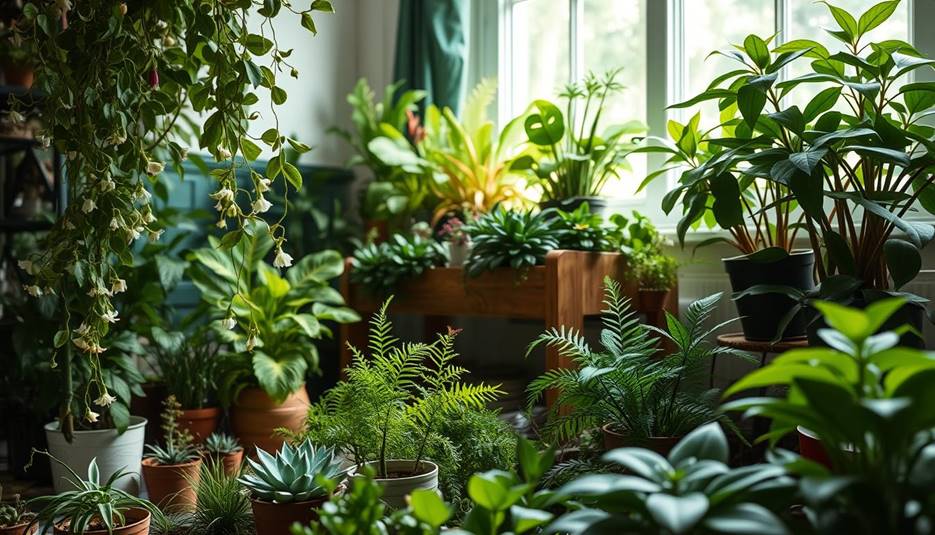
A study in 2022 showed that houseplants can lower blood pressure. It looked at many research studies. We found that people with plants in their homes have low blood pressure. Hypotension is just an advantage of internal plants. Adding plants to your home can help your heart health.
How Indoor Plants Reduce Stress Levels
Indoor plants can make your home feel calmer. Caring for them is soothing. Seeing greenery can also take your mind off stress.
For the best stress relief, pick easy plants like succulents. They need little care and can brighten up your space.
Plants That Improve Focus and Productivity
Some plants can help you focus and work better. Snake Plants and Spider Plants are great. They clean the air and make you feel good.
Adding houseplants to your home is a smart way to improve your well-being. By picking the right plants, you can make your home a healing space for your health.
Creating a Peaceful Home Environment Through Mindful Design
Mindful design helps make your home a place of well-being. It adds mindfulness to your home’s design. This creates a peaceful living space that helps you relax and lowers stress.
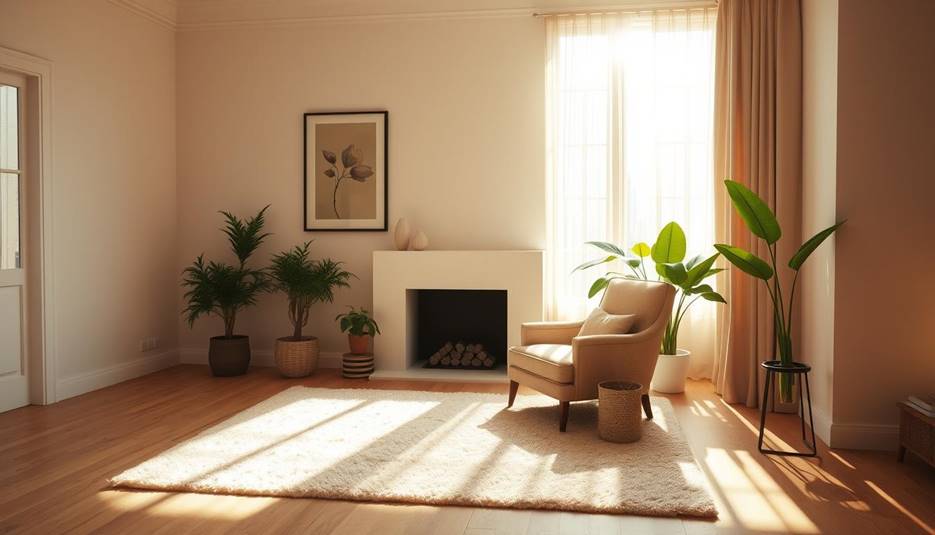
Decluttering is key to a peaceful home. Clutter can make you feel anxious and overwhelmed. By getting rid of things you don’t need, you can clear your mind and feel less stressed.
Start by removing items you no longer use. Organize what’s left in a way that fits your life.
As the famous designer,
William Morris once said, “Have nothing in your house that you do not know to be useful, or believe to be beautiful.”
This quote shows the importance of decluttering and mindful design.
Organizing Spaces to Support Daily Wellness Routines
Organizing your home for wellness routines can greatly improve your well-being. Make a mindfulness at-home area for meditation or yoga. Design a space where peace takes the lead—keep it quiet, cozy, and free from mental clutter like noise, distractions, or digital chaos.
• Find areas in your home for wellness routines.
• Make a schedule to keep your space organized.
• Add elements of nature, like plants or water, for a calming feel.
Creating Dedicated Relaxation Zones
Having special areas for relaxation can help you unwind. Think about a relaxing home ideas corner with a comfy chair, soft lights, and calming colors. It’s your spot to relax after a busy day.
By using these mindful design tips, you can make a home that supports your health. Aim to create a sanctuary where you can relax, recharge, and feel well through decluttering for emotional clarity.
Nature-Inspired Materials for Indoor Wellness
Natural materials can make your home feel better. Adding wood, stone, and plants can make your space more welcoming and healthy.
Local Natural Materials and Mood Improvement
Using local natural materials can really boost your mood. Studies show they can make you feel less stressed and more connected to your community.
Benefits of Local Natural Materials:
- Improved mood
- Reduced stress levels
- Enhanced sense of community
Textures and Finishes That Enhance Environmental Connection
The feel and look of natural materials matter too. For instance, the roughness of stone or the smoothness of driftwood can make your space more interesting.
“The use of natural materials in interior design can create a sense of warmth and coziness, making a house feel more like a home.”
Experimental Findings on Natural Décor During COVID Quarantine
Research during the COVID-19 lockdown found that natural decor can help. It can lower stress and improve mental health. This shows natural materials can support your emotional well-being at home.
The use of natural elements in your home is more than just looks. It’s about making your living space healthier.
Choosing and using natural materials wisely can improve your home’s wellness. It can also make your living space more peaceful.
Light, Color, and Sound: Sensory Elements for a Healthier Home
The elements of light, color, and sound in your home are key to your health and happiness. Knowing how they affect you can help you make your home better for your well-being.
Natural Light and Its Impact on Mood and Sleep
Natural light is vital for your body’s internal clock, which affects your mood and sleep. Being in natural light during the day boosts serotonin, making you feel better and more energetic. Not enough natural light can make you feel sad and tired.
To get more natural light in your home, try these tips:
- Keep windows clear to let sunlight in.
- Use mirrors to bounce natural light into dark spots.
- Opt for light-colored curtains or blinds that open easily.
Color Psychology for Different Rooms
Colors can really change how you feel and act. Each room has its own purpose, and the colors should match. For example, soft blues and greens are great for bedrooms because they help you relax and sleep better.
Research shows that:
|
Room |
Recommended Color |
Effect |
|
Bedroom |
Soft Blues, Pale Greens |
Promotes relaxation and improves sleep quality |
|
Living Room |
Warm Neutrals, Earth Tones |
Creates a welcoming and cozy atmosphere |
|
Home Office |
Bright Whites, Focused Greens |
Enhances concentration and productivity |
“Colors are the smiles of nature.” –
Leigh Hunt
Nature Sounds and Their Stress-Reducing Effects
Nature sounds, like rain or waves, can lower stress and boost your mood. You can add these sounds to your home with sound machines or apps.
Studies show that nature sounds can decrease stress hormones, heart rate, and blood pressure. To enjoy nature sounds at home, you can:
- Use a sound machine or app with different nature sounds.
- Put the device in a room where you spend a lot of time.
- Find the right volume for you.
By adding natural light, choosing the right colors, and using calming nature sounds, you can make your home healthier and more relaxing.
Air Quality Improvements for a Healthier Living Space
To support your health, improving your home’s air quality is key. The air inside your home affects your well-being. It impacts your breathing and even your mind.
Natural Ventilation Strategies
One easy way to better air quality is natural ventilation. Just open your windows and doors. This lets in fresh air and cuts down on indoor pollutants.
Tips for Effective Natural Ventilation:
- Open windows during cooler parts of the day to inhale some fresh air.
- Use fans to circulate air and enhance ventilation.
- Consider installing vents or whole-house fans for improved airflow.
Reducing Indoor Pollutants and Toxins
Many indoor pollutants come from cleaning products, paint, and furniture. To reduce them, you need to control sources, ventilate, and purify the air.
|
Pollutant Source |
Reduction Strategy |
|
Household Cleaning Products |
Switch to eco-friendly, non-toxic cleaning products. |
|
Paint and Furniture |
Choose products with low VOC (Volatile Organic Compound) emissions. |
|
Mold and Moisture |
Fix leaks, improve ventilation, and use a dehumidifier. |
Humidity Control for Optimal Health
Keeping the right humidity is vital for air quality. Too much or too little can harm your health, from breathing problems to dry skin.
Humidifiers or dehumidifiers can help keep humidity between 30-50%. Regular upkeep is key to stop mold.
By using these methods, you can make your home’s air healthier. This supports your overall well-being.
Conclusion: Transforming Your Home into a Health-Supporting Sanctuary
Making your home peaceful is key to staying healthy and feeling good. This can be done by adding elements such as biophysiological design, houseplants, and natural materials. Wellness routine. These things help make your home a place of calm and well-being.
To start making your home a healing space, focus on being mindful. Declutter and organize your home. This will help you feel less stressed and more focused.
As you work on making your home a sanctuary, think about how to make it peaceful. Simple changes can greatly improve your health and happiness. Enjoy the calm and comfort of your new peaceful living space.






GIPHY App Key not set. Please check settings